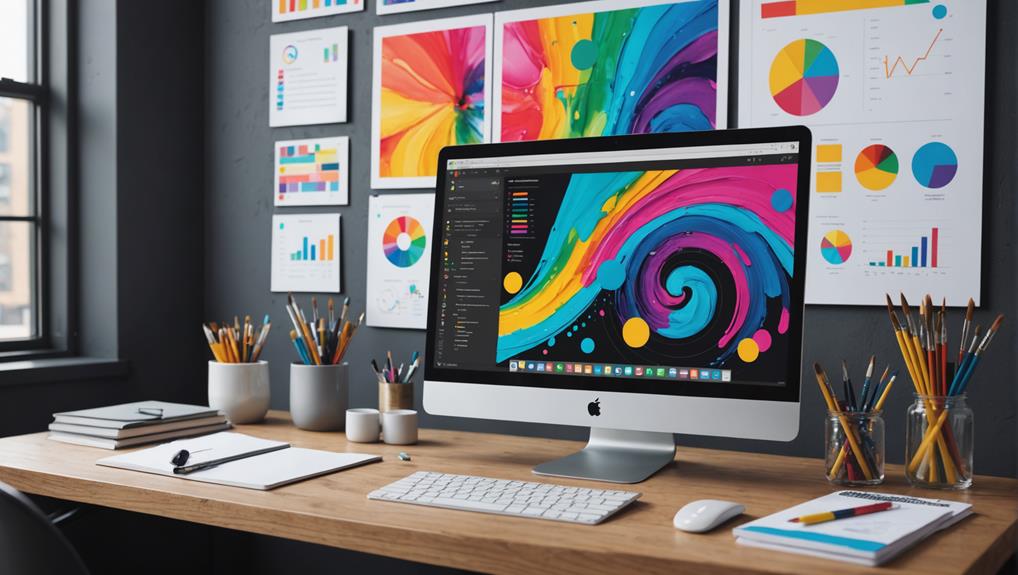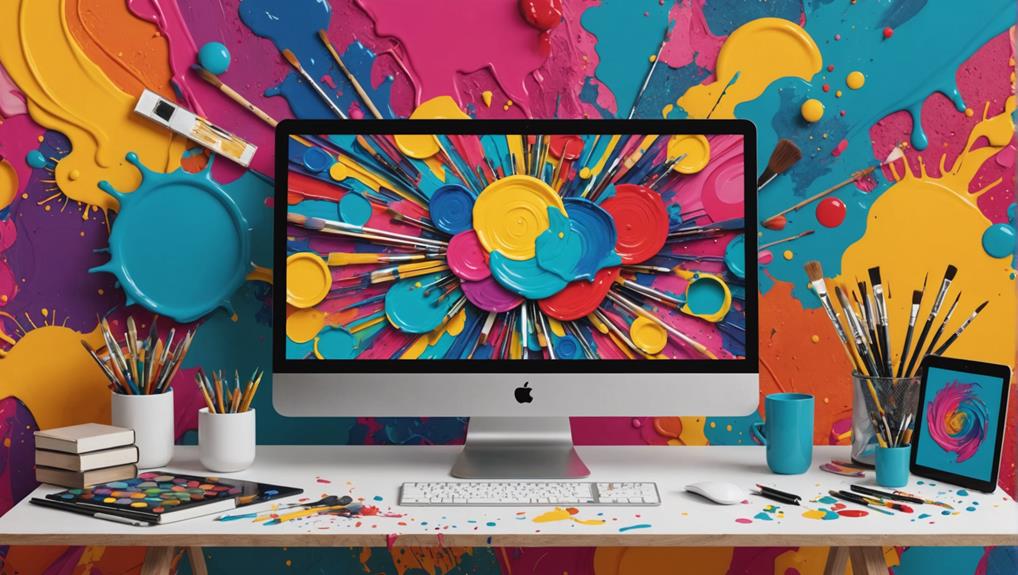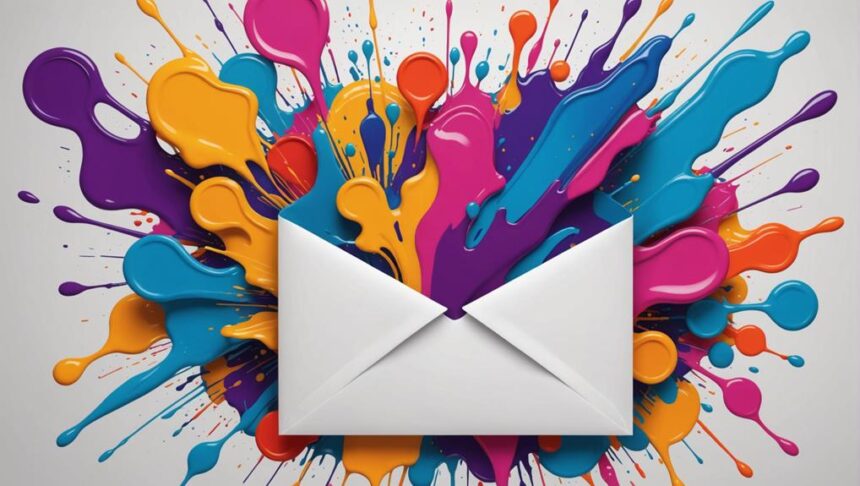For fluid artists aiming to thrive in their craft, email marketing can make all the difference! Imagine having a direct line to your audience, where you can showcase your vibrant creations and share behind-the-scenes magic. Start by building an email list—offer exclusive artwork previews or discounts to entice sign-ups. Keep it simple: just a click to join! Use tools like Mailchimp to send targeted messages, ensuring each email hits home. Sharing high-quality images of your latest work or sneak peeks of upcoming exhibitions can excite subscribers. The next steps will reveal more tips to enhance your artistic brand!
Key Takeaways
- Offer exclusive content like early access to artwork and limited-time discounts to entice subscriptions.
- Use high-quality visuals and compelling subject lines to increase open rates and audience engagement.
- Simplify the signup process with visible forms on websites and social media to boost subscription rates.
- Segment the email list for personalized content delivery, improving click-through rates and revenue.
Importance of Email Marketing
Email marketing is a pivotal tool for artists, enabling direct and meaningful engagement with their audience. Imagine having a platform where you can speak directly to your fans, sharing your latest creations, stories, and events. This is what email marketing offers. The average person checks their email daily, so your messages have a high chance of being seen. Unlike social media, where posts can get lost in the noise, emails allow for targeted messaging directly to those who care about your work.
One of the biggest advantages is email engagement. You can craft personalized messaging that resonates deeply with your audience. For instance, you can share the behind-the-scenes process of your latest artwork, offering a sneak peek that feels exclusive. This personalization builds a stronger connection, making your audience feel valued and involved in your journey.
Moreover, the numbers don't lie. The global email marketing market was valued at $7.5 billion in 2020, and it's projected to reach $17.9 billion by 2027. This growth underscores its effectiveness as a marketing strategy. Regular emails keep your audience updated and excited, fostering a loyal fan base that is more likely to support your art.
Building an Email List
Building an email list is essential for artists wanting to connect directly with their audience.
By offering exclusive content like behind-the-scenes access or limited edition prints, you can entice visitors to subscribe.
Additionally, using simple sign-up forms and segmenting your list allows for targeted messaging that keeps your subscribers engaged and coming back for more.
Offer Exclusive Content
Providing exclusive content to your audience is a powerful strategy for growing an engaged and loyal email list. Imagine giving your subscribers something special that they can't get anywhere else. Exclusive downloads, like e-books or printables, can be a fantastic way to boost subscriber engagement and make them feel valued.
Think about it—who wouldn't love a behind-the-scenes look at your creative process? Sharing how you mix your colors or prepare your canvases can be incredibly intriguing for your fans. Early access to new artwork is another great perk. It makes your subscribers feel like VIPs, giving them a sneak peek before anyone else.
Limited-time discounts or special offers exclusively for email subscribers can create a sense of urgency. People love feeling like they're getting a special deal, and it's a great way to encourage sign-ups.
Plus, regularly updating your subscribers on upcoming events or exhibitions adds value, making your email list something they look forward to.
Simplify Signup Process
Offering exclusive content is invaluable, but to maximize its impact, it's important to simplify the signup process for your audience.
First off, the easier it is to sign up, the more likely people are to do it—think of it like this: would you rather jump through hoops or just click once to join an awesome club? That's why one-click signup forms can boost your subscribers by a whopping 25%.
Make sure your signup forms are front and center on your website and social media pages, where everyone can see them. Trust me, visibility is key!
Use clear, concise language to make the benefits of joining your email list crystal clear. Speak their language and tell them exactly what they'll get—whether it's exclusive content, discounts, or other signup incentives.
And hey, who doesn't love a good incentive? Offering something immediate and valuable can be the nudge someone needs to hit that subscribe button.
Lastly, don't forget to comply with privacy laws by using opt-in forms. This helps build trust, showing your audience you respect their privacy, which can lead to better long-term engagement and loyalty.
Keep it simple, keep it effective!
Segment and Target Audience
Segmenting your email list enables you to deliver highly personalized content that resonates with specific audience groups, markedly boosting engagement and conversion rates. For fluid artists, this means tailoring your messages based on demographic analysis and behavioral targeting. This approach not only guarantees your emails are relevant but also dramatically increases your chances of turning subscribers into loyal customers.
To illustrate:
| Segmentation Criteria | Example Use | Benefit |
|---|---|---|
| Demographic Analysis | Age, Gender | Tailor content to specific groups |
| Behavioral Targeting | Purchase history, Website activity | Send targeted promotions |
| Preferences | Art styles, Material interests | Personalized recommendations |
Using opt-in forms to gather information like location or preferences keeps your campaigns compliant with data protection laws and gives you valuable insights for future strategies. Regularly cleaning your email list is also essential. By removing inactive subscribers, you focus on those genuinely interested, maintaining high engagement rates.
Engage with your audience through surveys to learn more about their preferences. This feedback will help refine your segmentation, making your campaigns even more effective. Remember, targeted messaging can generate up to 760% more revenue compared to non-segmented campaigns, making this strategy indispensable for any serious fluid artist.
Email Marketing Tools

In the domain of email marketing, tools like Mailchimp, Constant Contact, and Hubspot stand out for their user-friendly interfaces, robust automation features, and thorough analytics.
These platforms make email automation a breeze, allowing you to schedule your campaigns and send targeted messages based on your subscribers' behaviors. This not only saves time but also guarantees that your communications are timely and relevant.
Template customization is another fantastic feature offered by these tools. You can choose from a variety of visually appealing templates, which can be tailored to fit your brand's aesthetic. Plus, these templates adjust to Dark Mode preferences, making your emails easier to read and more engaging for your audience.
Most email marketing platforms also include segmentation options. This means you can categorize your audience based on demographics or interests, allowing for more personalized outreach.
Tracking and reporting features are also at your disposal, enabling you to measure key performance indicators like open rates and click-through rates. This data is invaluable as it helps you make informed adjustments to improve your future campaigns.
Crafting Effective Campaigns
Crafting an effective email campaign requires a strategic approach that focuses on clear, concise messaging and visually appealing content to captivate your audience. The key to a successful campaign lies in focusing on one or two main topics, guaranteeing the message resonates with recipients to boost audience engagement.
Engaging subject lines are pivotal, as they can increase open rates by up to 50%. Additionally, using high-quality email marketing software can automate and analyze your campaigns, enhancing efficiency and targeting. Consistent design elements, such as colors and fonts, help with brand recognition, making your emails instantly recognizable.
| Key Element | Description |
|---|---|
| Message Focus | Concentrate on 1-2 main topics to keep messaging clear and effective. |
| Engaging Subject Lines | Catchy subject lines can notably boost open rates. |
| Visual Content | Use images of new artwork or events to capture attention. |
Campaign timing is critical; sending emails when your audience is most likely to engage can make a notable difference. Including visually appealing content, like images of new artwork, guarantees your emails are not only opened but also drive traffic to your website or social media platforms. By integrating these strategies, fluid artists can create compelling campaigns that foster strong audience connections and boost engagement.
E-shot Content Ideas

When crafting your e-shot, think about showcasing your latest fluid art pieces with high-quality images, titles, and pricing details to captivate buyers and collectors.
Promote upcoming events by inviting subscribers to exclusive previews, creating excitement and a sense of community around your work.
Additionally, highlight recent achievements or offer special promotions to keep your audience engaged and enthusiastic for more.
Showcase New Artwork
Showcase your new artwork effectively in e-shots by incorporating high-quality images, compelling titles, and clear pricing details to capture attention and drive engagement.
A strong artistic presentation is essential; use high-resolution photos that highlight the intricate details and vibrant colors of your pieces. Complement these visuals with compelling titles that reflect the essence of each artwork, and don't forget to include clear pricing to make it easy for interested buyers to take the next step.
Visual storytelling can greatly enhance the appeal of your e-shots. Share the story or inspiration behind each piece – perhaps a fleeting moment that sparked an idea, or the emotions you poured into the creation. This connection can evoke an emotional response from your audience, making your artwork more memorable and meaningful.
Additionally, consider offering exclusive sales or promotions for your subscribers. This not only incentivizes purchases but also fosters a sense of loyalty among your audience.
Utilize links to your social media and website to increase visibility and encourage sharing, expanding your reach and attracting new fans.
Promote Upcoming Events
Effectively promote your upcoming events in e-shots by providing detailed information about exhibition dates, locations, and ticket availability to keep your audience informed and engaged. Including intriguing images of your artwork or event setups can visually entice your subscribers, encouraging them to attend. Additionally, highlighting special features such as guest speakers or interactive sessions can add value and draw interest from potential attendees.
Using countdown timers or RSVP links in your emails creates a sense of urgency, prompting immediate action from your audience. Offering exclusive previews or early-bird ticket discounts as incentives can further enhance audience engagement. These strategies not only keep your subscribers excited but also help in effectively promoting your events.
To give you a clearer picture, here's a breakdown:
| Event Detail | Description | Benefit |
|---|---|---|
| Exhibition Dates | Specific dates of the event | Keeps audience informed |
| Locations | Exact venue details | Easy for attendees to plan |
| Ticket Information | Availability and pricing details | Encourages timely purchases |
| Special Features | Guest speakers, interactive sessions | Adds value and interest |
| Exclusive Offers | Previews, early-bird discounts | Incentivizes attendance |
Incorporating these elements into your e-shots guarantees your event promotion is thorough and engaging, making your audience feel excited and valued.
List Segmentation Tips
Incorporating list segmentation in your email marketing strategy allows artists to deliver more personalized and engaging content to their subscribers. By categorizing your audience based on subscriber preferences and behavior analysis, you can tailor your messages to meet the unique interests and needs of each group. This approach not only makes your emails more relevant but also greatly boosts engagement.
Imagine sending out event updates. Instead of a generic message, you can target art lovers who have shown interest in similar events before, making your invites more appealing. Similarly, offering discounts on supplies to those who have purchased from you previously can lead to higher click-through rates. In fact, studies show that segmented email campaigns achieve 14.31% higher open rates and 100.95% higher click-through rates compared to non-segmented ones.
The magic lies in using customer data effectively. Regularly updating your segmentation criteria based on subscriber behavior guarantees that your content stays fresh and relevant. This not only helps in maintaining high engagement levels but also fosters a deeper connection and loyalty between you and your fans.
Measuring Campaign Performance

Measuring the performance of your email campaigns is essential for understanding their impact and optimizing future efforts.
It's vital for fluid artists to explore KPI analysis to see what's working and what's not. While open rates are becoming less significant, focusing on unsubscribe rates and click-through rates (CTR) is now the way to go in 2023. This shift helps you understand your audience's engagement better and refine your strategies.
Nearly half of marketers see return on investment (ROI) as a top KPI, underscoring the importance of evaluating the financial success of your email efforts. Regularly exploring metrics like engagement, conversions, and list growth can pave the way for more effective campaigns.
Here's a quick checklist to help you measure your email campaign performance:
- CTR and Unsubscribe Rates: Keep an eye on these to gauge engagement and retention.
- ROI: Calculate the financial return to assess the campaign's success.
- A/B Testing: Experiment with different subject lines and content to see what resonates.
- Engagement Metrics: Track metrics like time spent reading emails and interaction rates.
Frequently Asked Questions
What Are the 7 Email Marketing Strategies?
To optimize email marketing, implement these seven strategies: segment your target audience, use automation, craft compelling subject lines, employ visually appealing and creative content, optimize for Dark Mode, analyze KPIs, and make data-driven adjustments.
What Makes a Good Email Marketing Strategy?
A good email marketing strategy involves segmenting the target audience and employing content personalization. This approach enhances engagement and effectiveness, leading to higher conversion rates and fostering stronger relationships with subscribers.
How Do You Optimize Email Marketing Strategy?
To optimize your email marketing strategy, employ audience segmentation to tailor messages to specific demographics. Enhance engagement through content personalization, ensuring your emails resonate with individual preferences and lead to improved open and click-through rates.
How Can I Be Successful in Email Marketing?
To be successful in email marketing, focus on email list building and audience segmentation. Develop a targeted email list and tailor content to specific segments, enhancing engagement and driving higher conversion rates through personalized communication.
Conclusion
Email marketing emerges as a pivotal strategy for fluid artists seeking to expand their audience and increase engagement.
By constructing a robust email list, utilizing specialized tools, and crafting compelling campaigns, artists can effectively communicate with their audience.
Incorporating diverse content and segmenting the email list guarantees tailored messaging.
Measuring campaign performance is essential for continual improvement.
A structured approach to email marketing can greatly enhance the visibility and success of fluid artists in the competitive art market.


Leave a Reply